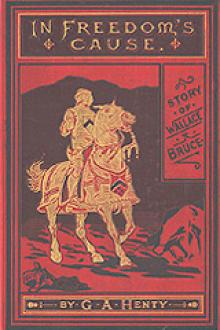The Scottish Chiefs, Jane Porter [best ereader manga TXT] 📗

- Author: Jane Porter
Book online «The Scottish Chiefs, Jane Porter [best ereader manga TXT] 📗». Author Jane Porter
This scarf belonged to, and was worn by the truly royal, but something romantically adventurous King of Scotland, James the Fifth. He was fond of roaming about in his dominions, like the celebrated Haroun Al Rashid, in various disguises, to see and to observe; and to make acquaintance with his people of all degrees, without being known by them. In one of these incognito wanderings, about the year 1533, he was hospitably entertained for a night, by an ancestor of Dr. Jefferson's lady, a man of liberal name in the country; and who unwittingly had given most courteous bed and board to his sovereign (then personally unknown to him), when he thought he was entertaining a person not much above the rank of the commonest degree, it being the monarch's humor generally to assume the most ordinary garb outwardly; and it therefore depended on the tact of the entertainer, from his own inherent nobleness, to discern the real quality of the mind and manners of his transitory guest. The host in question did not discern that it was his sovereign he was then treating like a prince; but he felt it was a visitant, be he whom he may, that was worthy his utmost respect; and the monarch, highly pleased with his night's lodging, and previous gracious welcome, on his departure next morning, presented to the lady of the mansion a grateful tribute to her good care, in the form of a small parcel rolled up, which, when opened, they found to be a splendid scarf, indorsed to herself and lord, in the name of the Gudemon o' Ballangeich. All then knew it was the "generous and pleasant King of Scotland" who had been their guest.
The Scottish Chief on whom this beautiful memorial of received hospitality had been bestowed, was John Baird, of Burntisland, in Fifeshire, from whom the writer of this note literally traces the present inheritance of the scarf. John Burgh had an only daughter, who married John Balfour, K. N., who also had an only daughter, and she married Gilbert Blair, brother to Blair of Ard-Blair. Their only son, James Blair, married Jane Morrison, daughter of — Morrison, Esq., and an heiress of the brave house of Ramsay, by which marriage the ancient and honorable families of Burgh, Blair, and Ramsay, were woven into one branch; and from this branch, indeed, from the first set-off of its united stem was born of this marriage, Margaret Blair, who dying in the year 1836, bequeathed the long-cherished scarf to Dr. Jefferson, the worthy husband of her beloved kinswoman—direct in the line of John Burgh, to whom it had originally been given.
The scarf was composed of a rich and brilliant tissue of gold and silver threads, interwoven with silk-embroidered flowers in their natural colors. They are chiefly pansies, the emblems of remembrance; thistles, the old insignia of Scotland; and the field daisy, the favorite symbol of King James' mother, the beautiful Queen Margaret. The flowers, entwined together, run in stripes down the splendid web of the scarf, which terminates at each end with what has been a magnificent fringe of similar hues and brightness. The scarf is seven feet in length, by one foot nine inches in width.
This interesting bequest was still further enriched to Dr. Jefferson by the addition of a cap and gloves, which, tradition says, the worthy chief of Burntisland wore on his nuptial day. There was also a smaller pair of gloves, of a more delicate size and texture, appropriated by the same testimony to the fair bride. But these articles are supposed to have been of earlier fabric than that of the scarf—probably the year 1500—and they are of less exquisite manufacture; the former appearing to be from the fine looms of France, and the latter wrought in the less practiced machinery of our then ruder northern isle. The cap is of a pale red silk, with gold cord and embroidery down the seams, it being formed to fit the head, and therefore in compartments; broad where they are inserted into the rich fillet-band round the head, and narrowing to the closely-fitting top. It looked something like an Albanian cap. The gloves, which are said to have been those of the chief, were of a brownish fine leather, with embroidered gauntlet tops. The lady's are of a lighter hue, still softer leather, with gay fringe of varied-colored silk and gold, and tassels at the wrists. Both these pairs of gloves were well shaped and most neatly sewed.
On these relics of antiquity, and of ancestorial memorials devolving on Dr. Jefferson, he sought for a place of deposit for them, suitable to their dignity, their character, and their times. He had in his possession a curious old table, of the era of Henry the Eighth, which he soon adapted to the purpose. Its large oaken slab was of sufficient dimensions to admit of the royal gift being spread in graceful folds over the dark surface of the wood, which the better displayed the tissue's interchanging tints, and also gave room for the disposal of the cap and gloves, which were placed in a kind of armorial crest between its gauntlets, at the head of the scarf, and at its foot was added a beautifully written inscription in old emblazoned characters, historic of the interesting relics above. The whole is secured from dust or other injury by a covering of plate-glass, extending over the entire surface of the table, which, having a raised carved oak parapet-border of about four inches high along all its sides, forms a sort of castellated sanctuary that completely defends from accident the glass and the treasure beneath it; which is distinctly seen through the lucid medium.
The shape of the table is like that we call a sofa-table, but very long, being five feet by two and a half. The depth of its frieze altogether is eight inches, for it extends four inches below the four-inch parapet above, and this lower portion is worked into a foliage enwreathing the sides. The whole height of the table from the feet of its four-clawed pedestal, is three feet two inches. This pedestal, or rather branching stem of polished oak—being of the sturdy contour of its original growth, with its superb ramifications supporting the precious slab above—shows an elaborate design in its carvings, far beyond my power to describe, so luxuriant, so various, so intricate, one might almost suppose that the matchless tool of the famous Benevanta Cellini had traced its wild and graceful grotesque. The four claws, which are like roots from the stem of the pedestal, partake of the same rich arabesque in their design, and terminate in the form of lion's paws.
The End.
End of the Project Gutenberg EBook of The Scottish Chiefs, by Jane Porter





Comments (0)